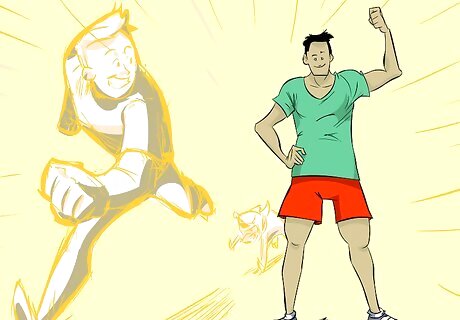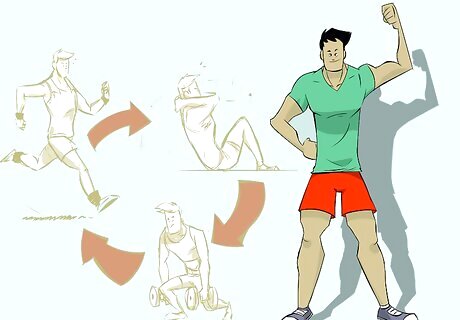
views
X
Research source
Professional sprinters strive to compete at events like the Olympics and the World Championships, and they compete in smaller more localized meets to earn a living. A lot of hard work and dedication are required to make it into the world of professional sprinting.
Beginning Your Journey as a Sprinter

Consider your genetics. With enough dedication, anyone can become a strong, decent sprinter. To be world-class, however, you have to have a certain genetic predisposition to speed. Look at your family. How athletic are your parents or grandparents? Are any of your older family members professional level athletes? Think about yourself as a child. Were you always faster than other kids? Do you possess a certain untrained natural athleticism?

Join the track and field team at your school. When you are considering becoming a professional athlete, you want to begin early. Being on a team will help give you accountability in your training. You’ll be able to have personalized coaching and build a community with your team. You’ll get experience running on difference tracks. On a team you’ll also learn to use starting blocks, which is an important part of being a competitive sprinter, as your race will be over in less than one minute, so you have to start out strong.

Create your own additional training routine. Even if you’re on a team, if you want to be a professional, you’ll need to train as much as you can. You’ll want to incorporate basic gym strength training like squats, bench pressing and chin-ups into your workout at least every other day for an hour. Create a basic gym routine, and try to increase your reps every week. This strength training is important because start speed is largely based on your muscle mass and overall strength in both your upper and lower body. As a sprinter, extra training is the only way to significantly increase upper body mass. Train on the track. You can often use a school track whenever it’s not in use. Practice your sprints in intervals with a few minutes of rest in between. Set weekly time goals for yourself. Try adding short sprints up hills to strength your fast twitch muscles, which are the leg muscles that set sprinters apart from long distance runners. Your exact routine will depend on your sprint distance. You should plan a sprint workout on the days that you aren’t doing strength training, at least three days a week. An example of a sprint training workout for running 200m races is as follows: 5 sets of 20 meter sprints, 4 sets of 30, 3 sets of 40, 3 sets of 30, 3 sets of 40, 3 sets of 50, 1 set of 60, and then 5 sets of 30. After each set, you should walk back to the start for a breath. After completing this routine, you should take a two-minute walking break, and then repeat the entire routine one more time. If you are younger, showing your parents that you are dedicated to practicing on your own will make them see that you’re serious about being a professional sprinter.

Obtain a private coach. If you are serious about becoming a professional and have the means to do so, you should consider getting a private running coach. Certified running coaches have training that will enable them to tailor your workouts to your specific needs and help you set realistic goals. Having a coach also increases your accountability for completing extra workouts outside of team practices. Your coach will be able to watch you closely and give you performance-based corrections on your form.
Continuing to Improve

Eat a healthy diet. Nutrition is an important part of being a sprinter. You want to make sure that you stay at a lean, consistent weight with a high muscle mass. Your diet should provide you with the energy you need to complete your training. . Incorporate protein. For every pound that you weigh, you should eat one gram of protein. This could be in the form of protein powder in smoothies or lean meats. Eat lots of fruit and dark green leafy vegetables. As a sprinter, you don’t need as many simple carbohydrates as long distance runners. Try to get your carbs from fruits, vegetables, and whole grains. Stay hydrated. Drink plenty of water, and drink sports drinks with electrolytes after workouts. Keep a food diary. Write down everything you eat. You’ll be able to use this information to see how your nutrition is affecting your running.

Perfect your technique. To become the fastest sprinter that you can be, you need to have flawless technique in addition to raw speed. Starting is important. At the start, your bodyweight should be evenly distributed between your four contact points. Push off with both legs. As the front leg straightens, and your back leg comes forward. In the acceleration phase, your lean begins to decrease. Your back becomes straighter. Legs reach higher. The body remains aligned upright. Add technique exercises, like knee raises and flicks to your every day training routine.

Ask for feedback. When you are working to become an elite athlete, it’s important to seek out corrections and criticism. After your school track and field meets, personally ask your coach what you could improve upon in your technique. Take this feedback, and use it to tailor your supplemental training exercises.

Keep a record of your progress. In a sport like sprinting, improvements are often numerically very small. Keep a notebook or computer spreadsheet up to date with all of your times and when you ran them. Add in goals to reach by certain dates. With this, you’ll be able to look back and check your progress.
Becoming a Professional

Invest in good shoes. In sprinting, athletes win by small increments. You want to make sure you are using proper footwear to ensure you perform your best and don’t get hurt. Look for shoes built for speed. Different types of running shoes suit different types of running professionals. Get a fitting. Most local running shops will have knowledgeable staff that will help you find shoes that fit you well. Many even have treadmills and systems that enable you to find the perfect shoe for your running style and foot.

Join a local club. Once you graduate from school, it can be beneficial to join a local track and field club team. This will give you continued support and accountability. If you live in the U.S., you can use the USA Track and Field club search to find one. Different clubs allow different ages to compete. Some are open to all athletes, some are youth-only, and some only allow 18 and over master adult athletes. Before you graduate, you can join a club in addition to your school’s team. Once you graduate, you’ll be able to intensify your involvement.

Compete often. As you’re becoming a professional, you want to compete as often as you can. This way you’ll have evidence of your professional record, as some prestigious races or teams, such as the Olympics, have specific eligibility times that you’ll need to be able to prove.

Keep training. Even as you start to compete more, you want to make sure that you maintain your regular training schedule and stay healthy.

Stay current on records. As an athlete, you want to know how other sprinters are competing. Make sure to keep current on record breaking times. Keeping up with top athletes will help you to set realistic goals for yourself. For example, Usain Bolt set the 100m world record in 2009 with a time of 9.58 seconds.



















Comments
0 comment